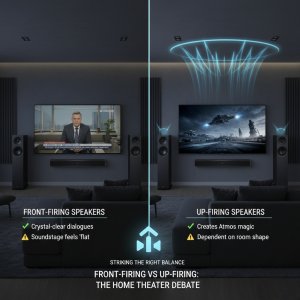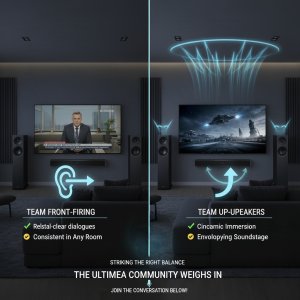harshjain1906
Well-known member
Hey Ultimea fam,
Let’s talk about something that quietly changes the way we enjoy sound - the direction of speakers. It’s not just about watts or number of channels, but where the sound is actually coming from.

 The Basics: Front-Firing
The Basics: Front-Firing
This is where most of us start. The sound comes straight at you from the front.
• Super clear for dialogues.
• Reliable for daily TV, music, and even casual movies.
• Doesn’t depend much on room shape.
Example: Watching a sitcom or a drama - you’ll catch every word without missing a beat.
 Why People Wanted More
Why People Wanted More
After a while, front-only sound started to feel flat. Movies and games are full of overhead action - planes, rain, thunder - but the sound was always at ear level. That’s when the need for “height” came in.
 The Upgrade: Up-Firing Speakers
The Upgrade: Up-Firing Speakers 
Up-firing speakers shoot sound upward, bounce it off the ceiling, and make it feel like it’s coming from above.
• Perfect for Atmos effects like helicopters, storms, or spaceships.
• Adds a whole new layer of immersion.
Example: In an action scene, when a jet zooms overhead, you actually feel it passing above your head, not just left to right.
 The Catch: Your Room Decides
The Catch: Your Room Decides
Here’s the truth—up-firing only works well in the right room.
• Low, flat ceilings? Works great.
• High, sloped, or soft ceilings? The effect drops a lot.
So sometimes people expect “cinema-level” and end up disappointed because of room limitations.
 Finding the Balance
Finding the Balance
• Front-firing = safe, clear, consistent.
• Up-firing = fun, immersive, but room-dependent.
A lot of people (including me) feel the best setups use both—front for clarity, up-firing for that extra magic layer.

What do you guys think?
• Do you stick with front-firing for simplicity?
• Or do you love the overhead feel of up-firing, even if it’s a bit tricky?
• And if you had to pick just one for your room, which way would you go?
Excited to read your thoughts—this one’s going to be interesting!
Harsh Jain
Let’s talk about something that quietly changes the way we enjoy sound - the direction of speakers. It’s not just about watts or number of channels, but where the sound is actually coming from.

This is where most of us start. The sound comes straight at you from the front.
• Super clear for dialogues.
• Reliable for daily TV, music, and even casual movies.
• Doesn’t depend much on room shape.
Example: Watching a sitcom or a drama - you’ll catch every word without missing a beat.
After a while, front-only sound started to feel flat. Movies and games are full of overhead action - planes, rain, thunder - but the sound was always at ear level. That’s when the need for “height” came in.
Up-firing speakers shoot sound upward, bounce it off the ceiling, and make it feel like it’s coming from above.
• Perfect for Atmos effects like helicopters, storms, or spaceships.
• Adds a whole new layer of immersion.
Example: In an action scene, when a jet zooms overhead, you actually feel it passing above your head, not just left to right.
Here’s the truth—up-firing only works well in the right room.
• Low, flat ceilings? Works great.
• High, sloped, or soft ceilings? The effect drops a lot.
So sometimes people expect “cinema-level” and end up disappointed because of room limitations.
• Front-firing = safe, clear, consistent.
• Up-firing = fun, immersive, but room-dependent.
A lot of people (including me) feel the best setups use both—front for clarity, up-firing for that extra magic layer.

Over to You
What do you guys think?
• Do you stick with front-firing for simplicity?
• Or do you love the overhead feel of up-firing, even if it’s a bit tricky?
• And if you had to pick just one for your room, which way would you go?
Excited to read your thoughts—this one’s going to be interesting!
Harsh Jain
